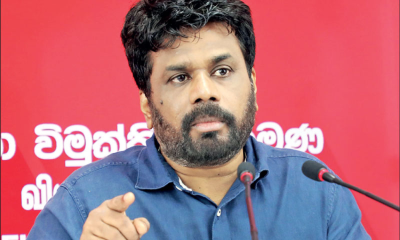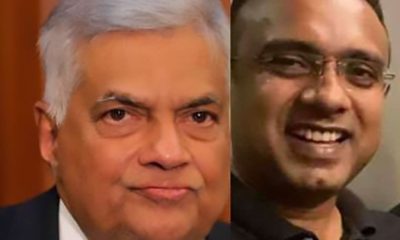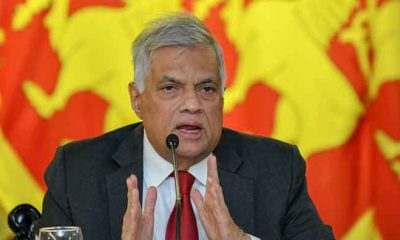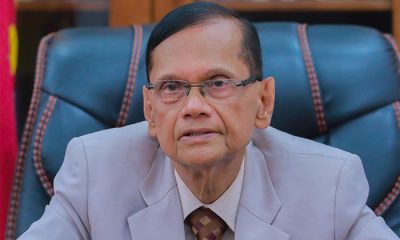Features
Errant politicians, voodoo economists and the verdict of learned judges

by Chandre Dharmawardana
chandre.dharma@yahoo.ca
The Supreme Court has ruled (with one dissenting against four assenting voices) on 14th November 2023 that three members of the Rajapaksa family, including two former Presidents and a coterie of their close officials were responsible for the country’s worst economic crisis that ended in bankruptcy.
The petition by civil society activists and NGOs named the current President, Ranil Wickremesinghe as the 1st respondent, while the respondent no. 32A was Gotabhaya Rajapaksa of Pangiriwatte Rd, Mirihana.
Ajith Cabraal, P. B. Jayasundara and other mandarins with murky reputations were found guilty, while academics and economists like Prof. Lakshman learnt that those who lie with the hounds are condemned to contract their fleas.
We consider two aspects of the petition in the following.
· It was claimed that the petitioners were not challenging the policy of the government in these proceedings, but they were challenging the “illegal, arbitrary, unreasonable or capricious executive and or administrative actions and or inactions”, … arising from arbitrary and/or capricious decisions, by the executive and/or administrative branches of the Government. It is contended that the respondents breached the ‘public trust’ reposed in them.
· Petitioners claimed that a series of capricious decisions taken by these politicians and their officials, including the decisions to revise taxes, artificially control the exchange rate, failure to contain the depletion of reserves, failure to promptly seek assistance from the International Monetary Fund (IMF), and the failure to optimally adjust interest rates were the main causes for this economic collapse.
When the learned judges concluded that these ministers and their mandarins were pursuing “illegal, arbitrary, unreasonable or capricious executive and or administrative actions and or inactions”, this can only resonate positively with the vast majority of Sri Lankans, as they themselves would have already come to that conclusion through their everyday experience.
However, it is the duty of the opposition to have highlighted these matters in Parliament, and exposed them through political, civil and judicial action. When Nanayakkara, Weerawansa and Gammanpila split off from the Rajapaksa-dominated cabinet in protest over signing of midnight deals and other shenanigans, they unwittingly triggered a process that was in sync with the Farmers’ Protests against the arbitrary banning of fertilisers, lack of gasoline and cooking fuel. So, it is surprising that the petitioners did not name as respondents some of the lethargic leaders of the opposition parties, and MPs who do not even attend parliament.
It is equally surprising that the petitioners did not indict the well-known architects of “Toxin-Free Lanka” who had paved the way for the collapse of the agriculture sector with the 2015 ban on glyphosate (weed killer) by the Sirisena administration, with the ban extended to all agrochemicals by Gotabhaya in 2021. The Aragalaya had in fact indicted all 225 MPs and demanded their demise.
The second aspect of the petition, covering economic strategies in regard to taxation, exchange rates, reserve funds, and the IMF constitute an epistemological conundrum since at least the time of Hammurabi.
While there was a “classical period” when people believed that economics can be made into a reliable science where predictions are possible, today we understand that economic systems are complex systems which may be fully deterministic and computable, but beyond prediction. Henri Poincare showed, towards the end of the 19th century that even perfectly well-defined simple systems subject to many interactions (even just three agents) were beyond prediction even though fully determined. This insight, known to mathematicians and physicists was finally applied to economic systems by von Neumann and others in the context of chaos theory, in the latter half of the 20th century.
If we are to go with the observations of the Nobel Laureate von Hayek (see his Nobel-prize address), or the mathematician von Mises, economic prediction is a bit like predicting the outcome of a football match or a game of cricket. Even if we had all the details of the players, the state of the grounds, coaches etc., the outcome is technically unpredictable although a good educated guess may be possible.
So, even with a vast array of the very best computers, and with the cream of economists at his beck and call, Allen Greenspan, then head of the US Federal Reserve bank had to admit that their team did not foresee the 2008 Economic collapse of Western economies. In fact, just a week prior to the collapse, Greenspan had given a clean bill of health to the US economy. Arguably, the Fed’s easy money policy of the early 2000s ultimately led to the 2007-2008 economic crisis, largely regarded as the worst financial downturn since the Great Depression. However, no one has petitioned against Greenspan. (See Fig. 01)
Just as the economic collapse in the US in 2008 may have roots going back to a decade, even the economic collapse of Sri Lanka must be viewed within a time frame longer than the period chosen by the petitioners in their submission to the supreme court.
In Figure 1 we show the evolution of Sri Lanka’s reserve coverage from 1950 to 2020. It is clear that the country was in the red already from 2010, and already too close to call since 1998. The sharp kink in 2008, coinciding with the Western economic collapse under Greenspan was followed by a period in Sri Lanka where the country’s reserve coverage went from bad to worse.
Availability of energy is the key factor determining economic and social evolution – a fact mostly ignored by social theorists who focus on chimeras like the class struggle, globalization or “industrialisation”. Industrialisation needs energy. A small country like Sri Lanka, importing fuel and even foodstuffs that it can grow in the country is captive to global fluctuations in trade that are beyond its control. Sri Lanka has to, and it can, generate most of its energy needs (see: Partitioning water between agriculture and hydro-power to maximise Sri Lanka’s clean energy output, Island 12-08-21). It can also achieve self-sufficiency in food.
This “home-grown” solution itself cannot be achieved to modern levels of sophistication without external inputs. Hence, Sri Lanka must also promote and invite foreign capital and investments. The country has been in the red since at least 2010. The Colombo Port City (CPC) project that was to infuse a large amount of forex into the country via the Chinese Belt Road initiative was converted into a disaster by Sri Lanka’s leaders bent on undermining the good works of each other.
It was during this “in the red” period (March 2011) that the CPC project was initiated under Mahinda Rajapaksa, with Xi Jinping himself visiting Sri Lanka, with a 15-billion-dollar budget. In addition, extensive investment complementing the Chinese-funded Hambantota harbour was envisaged. The international ambience was such that Western companies were investing in Chinese projects. There were immense prospects of a much-needed forex inflow into the country. The Western Province, the most dynamic regional entity in the country would have seen an immense efflorescence, synergizing the other neighbouring provinces if the full CPC had gone according to plan. Indonesia has successfully followed such a whole-hog “Chinese-Belt-Road” policy even though it has to face the full brunt of the China-US Pacific region’s power-play.
Unfortunately, the Yahapalanaya government of 2015 abruptly stopped the CPC as well as developments in the Hambantota port. Self-styled environmentalists claimed dire consequences from the CPC, although they have not garnered supporting environmental data even to date. Any confidence that investors would have had in coming to Sri Lanka evaporated with the capricious and politically short-sighted actions of the Yahapalanaya government, even though some of its leaders was committed to an extreme Ayan-Randian pro-trade policy.
Although the CPC and the Hambantota project were resumed, after paying large amounts of compensation in forex, and under terms less favourable to Sri Lanka, foreign-investor confidence remained shattered. Interestingly, it was during this period that Sri Lanka took upon itself large international sovereign-bond (ISB) loans. Meanwhile, President Sirisena initiated a 52-day coup that further shattered investor confidence. The ISB loans became critical factors in debilitating the yet-to-come Gotabhaya government with its inept finance ministers who believed that wheeler-dealing would always work. (See Fig. 02)
The reserve coverage continued to fall under the Yahapalanaya, as seen in Fig. 1. The purchase of ISGs continued without care, as seen in Figure. 2. Although the New York Times had invented the hypothesis of a “Chinese debt trap”, it is clear that the ISGs were the biggest debt burden of the Island nation. If civil society activists had gone before the supreme court and indicted the then President (Sirisena), and the then Prime Minister (Ranil Wickremasinghe) for their capricious and arbitrary actions, what would have been the verdict?
Decisions to “print money”, raise or lower taxes, and other tricks belong to the grey area of voodoo economics. A banker can “create money” by a mere book entry and lend it to an investor. The banker is betting on the future being rosy and recovering the money with interest! A central banker may lower taxes betting that it will help promote business and hence reap more tax revenue in the future. But what if this expected rosy future fails to arrive? What if an epidemic arrives, as actually happened in 2019?
Can a small nation entirely in the hands of wildly fluctuating global trade go gambling when its reserve holdings are themselves in the red? A country like the USA can get away with “just printing money” and such Voodoo economics; its currency is under-pinned in myriad ways including being the “petro-dollar”. Unfortunately, the Sri Lankan government threw caution to the winds and set sail on Voodoo economics. The Learned judges have rightly recognized this in their verdict.
The petitioners had indicted the respondents for not going to the IMF soon enough. However, as far as the present writer could ascertain, there was no national consensus of any sort in going to the IMF. The parliamentary debates show that no political leader, either in the government or in the opposition, clearly and unequivocally proposed that Sri Lanka should forth-with seek IMF assistance. Instead, we see much brave and resounding sovereignty statements where the IMF is presented (with good reason) as the mother of disaster capitalism and the harbinger of fire-sales of the assets of the country.
The degree of success obtained by the Wickremasinghe government in obtaining aid from the IMF is unlikely to have been achieved by the Rajapaksa regime that had no effective friends in Washington, Paris or Tokyo, while being hounded by the UN Huma-Rights secretariate under pressure from the US, Canada and UK with their large diasporas hostile to the Rajapaksas.
The regime had deeply angered its friendly Muslim Nations by its refusal of burials to Muslims who died of Covid. The unsubstantiated fear-mongering against burials was done by the very academics and medics who had pushed organic agriculture, claiming that agrochemicals are toxins fed to Sri Lankans since the 1970s. Not surprisingly, the Rajapaksa regime had to beg bilateral emergency help form Sri Lanka’s neighbours.
Availability of energy is the key to development. The first step in “saving Sri Lanka” is to achieve energy sovereignty using (a) its vast extent of aquatic bodies that can be used for floating solar installations while also conserving water; (b) cultivating fast-growing non-edible oil-producing plants like Castor for use as diesel and other fuels, and developing bio- and wind energy; (c) boosting Sri Lanka’s very low investment in higher education and research sharply; (d) following evidence-based science advise and rejecting eco-extremism and occult pseudoscience .
As energy becomes available, the corresponding Forex savings can be used for industrial and technical developments, with emphasis on agricultural, mineral and microbial techniques rather than highly capital-intensive technologies. Fast electric trains should take priority over highways for cars. The constitution has to be changed so that the public is not forced to select MPs from the same lists of corrupt candidates fielded by the leading parties. This Gordian knot of stale candidates can be broken by using the model of sortition to choose at least half the MPs, as discussed elsewhere.
Features
Sustaining good governance requires good systems

A prominent feature of the first year of the NPP government is that it has not engaged in the institutional reforms which was expected of it. This observation comes in the context of the extraordinary mandate with which the government was elected and the high expectations that accompanied its rise to power. When in opposition and in its election manifesto, the JVP and NPP took a prominent role in advocating good governance systems for the country. They insisted on constitutional reform that included the abolition of the executive presidency and the concentration of power it epitomises, the strengthening of independent institutions that overlook key state institutions such as the judiciary, public service and police, and the reform or repeal of repressive laws such as the PTA and the Online Safety Act.
The transformation of a political party that averaged between three to five percent of the popular vote into one that currently forms the government with a two thirds majority in parliament is a testament to the faith that the general population placed in the JVP/ NPP combine. This faith was the outcome of more than three decades of disciplined conduct in the aftermath of the bitter experience of the 1988 to 1990 period of JVP insurrection. The manner in which the handful of JVP parliamentarians engaged in debate with well researched critiques of government policy and actions, and their service in times of disaster such as the tsunami of 2004 won them the trust of the people. This faith was bolstered by the Aragalaya movement which galvanized the citizens against the ruling elites of the past.
In this context, the long delay to repeal the Prevention of Terrorism Act which has earned notoriety for its abuse especially against ethnic and religious minorities, has been a disappointment to those who value human rights. So has been the delay in appointing an Auditor General, so important in ensuring accountability for the money expended by the state. The PTA has a long history of being used without restraint against those deemed to be anti-state which, ironically enough, included the JVP in the period 1988 to 1990. The draft Protection of the State from Terrorism Act (PSTA), published in December 2025, is the latest attempt to repeal and replace the PTA. Unfortunately, the PSTA largely replicates the structure, logic and dangers of previous failed counter terrorism bills, including the Counter Terrorism Act of 2018 and the Anti Terrorism Act proposed in 2023.
Misguided Assumption
Despite its stated commitment to rule of law and fundamental rights, the draft PTSA reproduces many of the core defects of the PTA. In a preliminary statement, the Centre for Policy Alternatives has observed among other things that “if there is a Detention Order made against the person, then in combination, the period of remand and detention can extend up to two years. This means that a person can languish in detention for up to two years without being charged with a crime. Such a long period again raises questions of the power of the State to target individuals, exacerbated by Sri Lanka’s history of long periods of remand and detention, which has contributed to abuse and violence.” Human Rights lawyer Ermiza Tegal has warned against the broad definition of terrorism under the proposed law: “The definition empowers state officials to term acts of dissent and civil disobedience as ‘terrorism’ and will lawfully permit disproportionate and excessive responses.” The legitimate and peaceful protests against abuse of power by the authorities cannot be classified as acts of terror.
The willingness to retain such powers reflects the surmise that the government feels that keeping in place the structures that come from the past is to their benefit, as they can utilise those powers in a crisis. Due to the strict discipline that exists within the JVP/NPP at this time there may be an assumption that those the party appoints will not abuse their trust. However, the country’s experience with draconian laws designed for exceptional circumstances demonstrates that they tend to become tools of routine governance. On the plus side, the government has given two months for public comment which will become meaningful if the inputs from civil society actors are taken into consideration.
Worldwide experience has repeatedly demonstrated that integrity at the level of individual leaders, while necessary, is not sufficient to guarantee good governance over time. This is where the absence of institutional reform becomes significant. The aftermath of Cyclone Ditwah in particular has necessitated massive procurements of emergency relief which have to be disbursed at maximum speed. There are also significant amounts of foreign aid flowing into the country to help it deal with the relief and recovery phase. There are protocols in place that need to be followed and monitored so that a fiasco like the disappearance of tsunami aid in 2004 does not recur. To the government’s credit there are no such allegations at the present time. But precautions need to be in place, and those precautions depend less on trust in individuals than on the strength and independence of oversight institutions.
Inappropriate Appointments
It is in this context that the government’s efforts to appoint its own preferred nominees to the Auditor General’s Department has also come as a disappointment to civil society groups. The unsuitability of the latest presidential nominee has given rise to the surmise that this nomination was a time buying exercise to make an acting appointment. For the fourth time, the Constitutional Council refused to accept the president’s nominee. The term of the three independent civil society members of the Constitutional Council ends in January which would give the government the opportunity to appoint three new members of its choice and get its way in the future.
The failure to appoint a permanent Auditor General has created an institutional vacuum at a critical moment. The Auditor General acts as a watchdog, ensuring effective service delivery promoting integrity in public administration and providing an independent review of the performance and accountability. Transparency International has observed “The sequence of events following the retirement of the previous Auditor General points to a broader political inertia and a governance failure. Despite the clear constitutional importance of the role, the appointment process has remained protracted and opaque, raising serious questions about political will and commitment to accountability.”
It would appear that the government leadership takes the position they have been given the mandate to govern the country which requires implementation by those they have confidence in. This may explain their approach to the appointment (or non-appointment) at this time of the Auditor General. Yet this approach carries risks. Institutions are designed to function beyond the lifespan of any one government and to protect the public interest even when those in power are tempted to act otherwise. The challenge and opportunity for the NPP government is to safeguard independent institutions and enact just laws, so that the promise of system change endures beyond personalities and political cycles.
by Jehan Perera
Features
General education reforms: What about language and ethnicity?

 A new batch arrived at our Faculty again. Students representing almost all districts of the country remind me once again of the wonderful opportunity we have for promoting social and ethnic cohesion at our universities. Sadly, however, many students do not interact with each other during the first few semesters, not only because they do not speak each other’s language(s), but also because of the fear and distrust that still prevails among communities in our society.
A new batch arrived at our Faculty again. Students representing almost all districts of the country remind me once again of the wonderful opportunity we have for promoting social and ethnic cohesion at our universities. Sadly, however, many students do not interact with each other during the first few semesters, not only because they do not speak each other’s language(s), but also because of the fear and distrust that still prevails among communities in our society.
General education reform presents an opportunity to explore ways to promote social and ethnic cohesion. A school curriculum could foster shared values, empathy, and critical thinking, through social studies and civics education, implement inclusive language policies, and raise critical awareness about our collective histories. Yet, the government’s new policy document, Transforming General Education in Sri Lanka 2025, leaves us little to look forward to in this regard.
The policy document points to several “salient” features within it, including: 1) a school credit system to quantify learning; 2) module-based formative and summative assessments to replace end-of-term tests; 3) skills assessment in Grade 9 consisting of a ‘literacy and numeracy test’ and a ‘career interest test’; 4) a comprehensive GPA-based reporting system spanning the various phases of education; 5) blended learning that combines online with classroom teaching; 6) learning units to guide students to select their preferred career pathways; 7) technology modules; 8) innovation labs; and 9) Early Childhood Education (ECE). Notably, social and ethnic cohesion does not appear in this list. Here, I explore how the proposed curriculum reforms align (or do not align) with the NPP’s pledge to inculcate “[s]afety, mutual understanding, trust and rights of all ethnicities and religious groups” (p.127), in their 2024 Election Manifesto.
Language/ethnicity in the present curriculum
The civil war ended over 15 years ago, but our general education system has done little to bring ethnic communities together. In fact, most students still cannot speak in the “second national language” (SNL) and textbooks continue to reinforce negative stereotyping of ethnic minorities, while leaving out crucial elements of our post-independence history.
Although SNL has been a compulsory subject since the 1990s, the hours dedicated to SNL are few, curricula poorly developed, and trained teachers few (Perera, 2025). Perhaps due to unconscious bias and for ideological reasons, SNL is not valued by parents and school communities more broadly. Most students, who enter our Faculty, only have basic reading/writing skills in SNL, apart from the few Muslim and Tamil students who schooled outside the North and the East; they pick up SNL by virtue of their environment, not the school curriculum.
Regardless of ethnic background, most undergraduates seem to be ignorant about crucial aspects of our country’s history of ethnic conflict. The Grade 11 history textbook, which contains the only chapter on the post-independence period, does not mention the civil war or the events that led up to it. While the textbook valourises ‘Sinhala Only’ as an anti-colonial policy (p.11), the material covering the period thereafter fails to mention the anti-Tamil riots, rise of rebel groups, escalation of civil war, and JVP insurrections. The words “Tamil” and “Muslim” appear most frequently in the chapter, ‘National Renaissance,’ which cursorily mentions “Sinhalese-Muslim riots” vis-à-vis the Temperance Movement (p.57). The disenfranchisement of the Malaiyaha Tamils and their history are completely left out.
Given the horrifying experiences of war and exclusion experienced by many of our peoples since independence, and because most students still learn in mono-ethnic schools having little interaction with the ‘Other’, it is not surprising that our undergraduates find it difficult to mix across language and ethnic communities. This environment also creates fertile ground for polarizing discourses that further divide and segregate students once they enter university.
More of the same?
How does Transforming General Education seek to address these problems? The introduction begins on a positive note: “The proposed reforms will create citizens with a critical consciousness who will respect and appreciate the diversity they see around them, along the lines of ethnicity, religion, gender, disability, and other areas of difference” (p.1). Although National Education Goal no. 8 somewhat problematically aims to “Develop a patriotic Sri Lankan citizen fostering national cohesion, national integrity, and national unity while respecting cultural diversity (p. 2), the curriculum reforms aim to embed values of “equity, inclusivity, and social justice” (p. 9) through education. Such buzzwords appear through the introduction, but are not reflected in the reforms.
Learning SNL is promoted under Language and Literacy (Learning Area no. 1) as “a critical means of reconciliation and co-existence”, but the number of hours assigned to SNL are minimal. For instance, at primary level (Grades 1 to 5), only 0.3 to 1 hour is allocated to SNL per week. Meanwhile, at junior secondary level (Grades 6 to 9), out of 35 credits (30 credits across 15 essential subjects that include SNL, history and civics; 3 credits of further learning modules; and 2 credits of transversal skills modules (p. 13, pp.18-19), SNL receives 1 credit (10 hours) per term. Like other essential subjects, SNL is to be assessed through formative and summative assessments within modules. As details of the Grade 9 skills assessment are not provided in the document, it is unclear whether SNL assessments will be included in the ‘Literacy and numeracy test’. At senior secondary level – phase 1 (Grades 10-11 – O/L equivalent), SNL is listed as an elective.
Refreshingly, the policy document does acknowledge the detrimental effects of funding cuts in the humanities and social sciences, and highlights their importance for creating knowledge that could help to “eradicate socioeconomic divisions and inequalities” (p.5-6). It goes on to point to the salience of the Humanities and Social Sciences Education under Learning Area no. 6 (p.12):
“Humanities and Social Sciences education is vital for students to develop as well as critique various forms of identities so that they have an awareness of their role in their immediate communities and nation. Such awareness will allow them to contribute towards the strengthening of democracy and intercommunal dialogue, which is necessary for peace and reconciliation. Furthermore, a strong grounding in the Humanities and Social Sciences will lead to equity and social justice concerning caste, disability, gender, and other features of social stratification.”
Sadly, the seemingly progressive philosophy guiding has not moulded the new curriculum. Subjects that could potentially address social/ethnic cohesion, such as environmental studies, history and civics, are not listed as learning areas at the primary level. History is allocated 20 hours (2 credits) across four years at junior secondary level (Grades 6 to 9), while only 10 hours (1 credit) are allocated to civics. Meanwhile, at the O/L, students will learn 5 compulsory subjects (Mother Tongue, English, Mathematics, Science, and Religion and Value Education), and 2 electives—SNL, history and civics are bunched together with the likes of entrepreneurship here. Unlike the compulsory subjects, which are allocated 140 hours (14 credits or 70 hours each) across two years, those who opt for history or civics as electives would only have 20 hours (2 credits) of learning in each. A further 14 credits per term are for further learning modules, which will allow students to explore their interests before committing to a A/L stream or career path.
With the distribution of credits across a large number of subjects, and the few credits available for SNL, history and civics, social/ethnic cohesion will likely remain on the back burner. It appears to be neglected at primary level, is dealt sparingly at junior secondary level, and relegated to electives in senior years. This means that students will be able to progress through their entire school years, like we did, with very basic competencies in SNL and little understanding of history.
Going forward
Whether the students who experience this curriculum will be able to “resist and respond to hegemonic, divisive forces that pose a threat to social harmony and multicultural coexistence” (p.9) as anticipated in the policy, is questionable. Education policymakers and others must call for more attention to social and ethnic cohesion in the curriculum. However, changes to the curriculum would only be meaningful if accompanied by constitutional reform, abolition of policies, such as the Prevention of Terrorism Act (and its proxies), and other political changes.
For now, our school system remains divided by ethnicity and religion. Research from conflict-ridden societies suggests that lack of intercultural exposure in mono-ethnic schools leads to ignorance, prejudice, and polarized positions on politics and national identity. While such problems must be addressed in broader education reform efforts that also safeguard minority identities, the new curriculum revision presents an opportune moment to move this agenda forward.
(Ramya Kumar is attached to the Department of Community and Family Medicine, Faculty of Medicine, University of Jaffna).
Kuppi is a politics and pedagogy happening on the margins of the lecture hall that parodies, subverts, and simultaneously reaffirms social hierarchies.
by Ramya Kumar
Features
Top 10 Most Popular Festive Songs

Certain songs become ever-present every December, and with Christmas just two days away, I thought of highlighting the Top 10 Most Popular Festive Songs.
The famous festive songs usually feature timeless classics like ‘White Christmas,’ ‘Silent Night,’ and ‘Jingle Bells,’ alongside modern staples like Mariah Carey’s ‘All I Want for Christmas Is You,’ Wham’s ‘Last Christmas,’ and Brenda Lee’s ‘Rockin’ Around the Christmas Tree.’
The following renowned Christmas songs are celebrated for their lasting impact and festive spirit:
* ‘White Christmas’ — Bing Crosby
The most famous holiday song ever recorded, with estimated worldwide sales exceeding 50 million copies. It remains the best-selling single of all time.
* ‘All I Want for Christmas Is You’ — Mariah Carey
A modern anthem that dominates global charts every December. As of late 2025, it holds an 18x Platinum certification in the US and is often ranked as the No. 1 popular holiday track.

Mariah Carey: ‘All I Want for Christmas Is You’
* ‘Silent Night’ — Traditional
Widely considered the quintessential Christmas carol, it is valued for its peaceful melody and has been recorded by hundreds of artistes, most famously by Bing Crosby.
* ‘Jingle Bells’ — Traditional
One of the most universally recognised and widely sung songs globally, making it a staple for children and festive gatherings.
* ‘Rockin’ Around the Christmas Tree’ — Brenda Lee
Recorded when Lee was just 13, this rock ‘n’ roll favourite has seen a massive resurgence in the 2020s, often rivaling Mariah Carey for the top spot on the Billboard Hot 100.
* ‘Last Christmas’ — Wham!
A bittersweet ’80s pop classic that has spent decades in the top 10 during the holiday season. It recently achieved 7x Platinum status in the UK.
* ‘Jingle Bell Rock’ — Bobby Helms
A festive rockabilly standard released in 1957 that remains a staple of holiday radio and playlists.
* ‘The Christmas Song (Chestnuts Roasting on an Open Fire)’— Nat King Cole
Known for its smooth, warm vocals, this track is frequently cited as the ultimate Christmas jazz standard.

Wham! ‘Last Christmas’
* ‘It’s the Most Wonderful Time of the Year’ — Andy Williams
Released in 1963, this high-energy big band track is famous for capturing the “hectic merriment” of the season.
* ‘Rudolph the Red-Nosed Reindeer’ — Gene Autry
A beloved narrative song that has sold approximately 25 million copies worldwide, cementing the character’s place in Christmas folklore.
Other perennial favourites often in the mix:
* ‘Feliz Navidad’ – José Feliciano
* ‘A Holly Jolly Christmas’ – Burl Ives
* ‘Let It Snow! Let It Snow! Let It Snow!’ – Frank Sinatra
Let me also add that this Thursday’s ‘SceneAround’ feature (25th December) will be a Christmas edition, highlighting special Christmas and New Year messages put together by well-known personalities for readers of The Island.
-

 Midweek Review7 days ago
Midweek Review7 days agoHow massive Akuregoda defence complex was built with proceeds from sale of Galle Face land to Shangri-La
-

 News6 days ago
News6 days agoPope fires broadside: ‘The Holy See won’t be a silent bystander to the grave disparities, injustices, and fundamental human rights violations’
-

 News15 hours ago
News15 hours agoMembers of Lankan Community in Washington D.C. donates to ‘Rebuilding Sri Lanka’ Flood Relief Fund
-

 News6 days ago
News6 days agoPakistan hands over 200 tonnes of humanitarian aid to Lanka
-

 Business5 days ago
Business5 days agoUnlocking Sri Lanka’s hidden wealth: A $2 billion mineral opportunity awaits
-
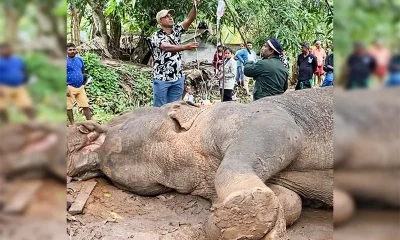
 News7 days ago
News7 days agoBurnt elephant dies after delayed rescue; activists demand arrests
-

 Editorial7 days ago
Editorial7 days agoColombo Port facing strategic neglect
-

 News5 days ago
News5 days agoArmy engineers set up new Nayaru emergency bridge




